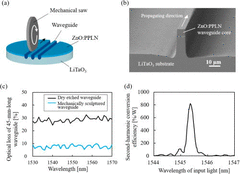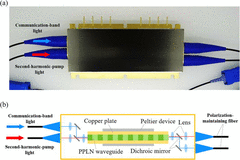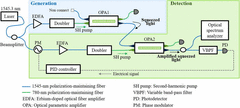


NTT: Realizing a large-scale photon computer in a rack size:
-Successful development of core technology for optical fiber-coupled quantum light sources-
Development overview:
Realization of light source module:
To realize a “rack-sized, large-scale photon computer”
Developed “optical fiber connection type high-performance squeezed light source module” which is a core device.
Uses optical components for optical communication:
We used “optical fiber coupled quantum light source module” and “optical components for optical communication”.
Over a wide band of 6 terahertz or more
Quantum noise is squeezed by 75% or more,
For the generation of continuous wave squeezed light
For the first time in the world, we succeeded in optical fiber optical system.
Contribution to photon computer development:
This result is
A development of “a stable and maintenance-free closed system for optical communication devices”.
We have made it possible to develop a photon computer on a realistic device scale.
In the future, the development of practical machines will make great progress.
Quantum computer:
Superposition state and quantum entanglement state
Utilizing phenomena peculiar to quantum mechanics,
Super parallel calculation processing is possible.
Strengths of photon computers:
Research and development is underway around the world.
Currently, various methods have been devised.
Among them,
“Optical quantum computer that calculates with photons, which are quantum of light” has many strengths.
Practical miniaturization is possible:
for example,
Since the freezing and vacuum equipment required by other methods is not required,
Practical miniaturization is possible.
Infinitely increase the number of qubits:
We can “create a continuous entangled state”.
We can “increase the number of qubits almost infinitely without integration or parallelization of equipment”.
High-speed calculation utilizing optical wideband:
High-speed calculation processing that takes advantage of the wide band of light is also possible.
Of course, quantum error correction is also possible.
Moreover,
Instead of representing a qubit with a single photon
A technique for representing qubits with a large number of photons,
It is also theoretically shown that “quantum error correction using the evenness of the number of photons is possible”.
Affinity with optical communication technology:
This method has a high affinity with optical communication technology.
Low-loss optical fiber in the communication wavelength band,
Using high-performance optical devices in optical communication,
We can expect dramatic development toward the construction of actual machines.
https://www.jst.go.jp/pr/announce/20211222-2/index.html
Photon Computer Research Support Fund | The University of Tokyo Fund
https://utf.u-tokyo.ac.jp/project/pjt93?reportId=pjReportDetail1
Fabrication of low-loss quasi-single-mode PPLN waveguide and its application to a modularized broadband high-level squeezer:
Applied Physics Letters: Vol 119, No 25
ABSTRACT
A continuous-wave (CW) broadband high-level optical quadrature squeezer
is essential for high-speed large-scale fault-tolerant quantum computing on a time-domain-multiplexed continuous-variable optical cluster state.
CW THz-bandwidth squeezed light
can be obtained with a waveguide optical parametric amplifier (OPA);
however,
the squeezing level has been insufficient for applications of fault-tolerant quantum computationbecause of degradation of the squeezing level due to their optical losses caused by the structural perturbation and pump-induced phenomena.
Here,
by using mechanical polishing processes, we fabricateda low-loss quasi-single-mode periodically poled LiNbO3 (PPLN) waveguide,
which shows 7% optical propagation loss with a waveguide length of 45 mm.
Using the waveguide,
we assembled a low-loss fiber-pigtailed OPA modulewith a total insertion loss of 21%. Thanks to its directly bonded core on a LiTaO3 substrate,
the waveguide does not show pump-induced optical loss even under a condition of hundreds of milliwatts pumping.Furthermore,
the quasi-single-mode structure prohibits excitation of higher-order spatial modes and enables us to obtain larger squeezing level.Even with including optical coupling loss of the modularization,
we observe 6.3-dB squeezed light from the DC component up to a 6.0-THz sideband in a fully fiber-closed optical system.
By excluding the losses due to imperfections of the modularization and detection,
the squeezing level at the output of the PPLN waveguide is estimated to be over 10 dB.
Our waveguide squeezer
is a promising quantum light source for high-speed large-scale fault-tolerant quantum computing.